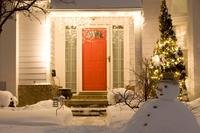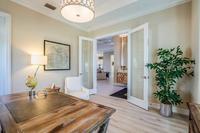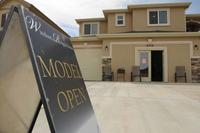I?ll start by confessing that this is one of a thousand articles on preparing your home for sale. Why so many, why one more, and why now? Because it is critically important -- now more than ever -- to seize that one time opportunity to make a good first impression. In many areas of the country, it is clearly the buyers market and home owners have too much riding on the sale of their home to miss the opportunity to make a great first impression. This article will address "curb appeal" and will be followed by an article next month on "staging" the interior of your home.
In a market with many homes, prospective buyers will drive up to a listing - and promptly drive on to the next listing if the curb appeal isn't there. Great curb appeal does not happen over night. The key elements are:
- Landscape
- Exterior trim and paint
- Landscape
- Clutter
- Landscape
- The Front Door
- Landscape
VR SAM recommends you ask a trained professional, your Realtor, to look at the exterior of your home with a critical eye well before you put your home on the market. Since you will pay your Realtor a substantial amount to market your home, we recommend you steel yourself up a bit, and ask them to tell it like it is, without concern for your feelings. Remember, your Realtor has shown hundreds (if not thousands) of homes and has observed prospective buyers' reactions to great and not so great curb appeal.
Let's take care of the easiest part first -- clutter. When you know you have a home tour, take care of the clutter. Even the best landscaped home in the neighborhood will not show well with cars parked in front of the home, bikes in the yard, etc. At a minimum, get the cars off the street, preferably into the garage. Find someplace else to park the RV, boat, and especially Dad's "project car" sitting on the blocks! Same with the bikes and all of the kiddies' toys. By the way, to the extent possible, keep it de-cluttered as many prospective buyers will tour neighborhoods on the weekends or evenings to see homes they may be interested in viewing.
The exterior trim and paint can be dealt with in a matter of a few weekends of "extra duty" around the house, but if you are a "do it your selfer," do it professionally or find a pro to do the repairs and touch-up work. Pay particular attention to screens that need to be replaced, shutters that require cleaning or painting and the external trim such as gutters, garage doors, and window facings. In many cases, a good power wash can make your home look newer.
The front door -- I broke this out separately because experienced Realtors will tell you by the time you have passed through that "front door" how the tour will end. No kidding! If it needs painted or repaired, or even replaced, then do it. Please note that few things stand out as much, in the negative sense, as an unprofessionally painted front door. If the screen/storm door doesn't close properly, is torn or cracked, get it repaired or replaced before you put your home on the market. If the front door key and/or lock are stiff or not working correctly, get it fixed or replaced. Don't allow the showing Realtor to be embarrassed while fumbling to get the front door open. The door the prospective buyers pass through will truly determine how they perceive what is inside the home.
Now for the part that can't be done over a few weekends. In my opinion, nothing has a bigger impact on curb appeal that a well designed and maintained landscape and lawn. These tips on basic landscape design and maintenance can help you sell your house:
General Landscape
- More is not necessarily better. The size of the home and the lawn, and how it is situated on the lot, should dictate the style and "amount" of landscape. Over planting a small house or lawn makes it look smaller. In front lawns, strive for simplicity and elegance.
- Overgrown trees and hedges will make your house look older and smaller than it is. Deciduous tree branches should normally not be lower than 6 feet to 8 feet off the ground. The normal person should be able to walk under them. Your foundation plantings and hedges should never grow above the lower part of the windows. Trimming your hedges frequently cause them to spread and avoid the heavy woody branches with little foliage.
- Plant the taller trees and shrubs on the ends of the house, with lower shrubs across the foundation and front to "frame" the house. Use ornamental trees and shrubs as a focal point in the vicinity of the front door.
- Some trees and shrubs simply over grow a lawn with time. Remove old landscape as necessary and replace with more appropriate plantings. By the way, many local garden centers will provide FREE landscape design if you buy the plants from them.
- Generally, front landscapes should emphasize year-round foliage and de-emphasize a large variety of annuals and / or multi-colored plants. Strive for simplicity and elegance instead of flash in the front landscape. Use annuals (that must be replaced every year) and perennials, including roses, sparingly in front lawns as they tend to be higher maintenance especially during the hot summer months. Save your favorite annuals (and roses) for the back yard. I also discourage evergreens such as junipers, pines, arborvitaes or yews as they tend to develop "rusts" and other diseases that create large gaps in the landscape. And if not carefully selected, these plants will overgrow the front yard. I recommend that your favorite garden statue and fish pond be used in your backyard landscape, and by all means, do not place the little yellow "windmills" or beetle traps in the front landscape.
- If climate allows, "broadleaf evergreens" such as rhododendrons, azaleas, camellias, hollies, etc. offer an excellent variety of bloom colors. If selected carefully, and combined with limited deciduous shrubs, you can enjoy year round foliage with something blooming almost continuously. They also make excellent foundation plantings and are relatively low maintenance.
- Plantings typically look more natural when clustered in odd numbers as opposed to "lined" up. Using a combination of clustering in front of your "lined up" foundation plantings can create a very pleasing front landscape. The smaller ornamental grasses are also a low maintenance, inexpensive means of providing year round foliage and color as well.
- Using curved, balanced, but asymmetrical beds, with fresh shredded mulch can create a very pleasing house landscape.
Caution: It is a good idea to use treated mulch only and to keep the mulch about one foot off the exterior of the house.
There's "GREEN" in your Lawn
- Ever wonder why the guy down the streets lawn always looks green? You fertilize, water, etc., but just don't get the color. His secret is LIME. Depending on your soil conditions and lawn size you may need hundreds of pounds of lime on your lawn twice a year. The good news is lime is cheap. If in doubt, have your lawn tested, or break down and ask your neighbor. Chances are his soil PH is similar to yours.
- Weed control is very problematic. However, the best weed defense is a good offense. Watering your grass and over seeding annually are excellent starts, but you may want to consider hiring a professional company to provide continuous weed control.
- Cut high, cut sharp, cut often! Generally, most grasses should be cut at about three inches height with a sharp mower blade. Scalping the lawn means you won't have to cut often, but at the cost of healthy grass. And you can be certain that weeds will then replace the healthy grass! Also, be sure to bag the grass clippings for curb appeal and lawn health. Watering your grass in the early AM saves your water resource and the grass prefers it as well. Evening watering tends to create an environment where diseases flourish and mid day waterings just evaporate.
- Finally, edge the sidewalk and beds routinely and weed eat in the necessary areas to set off your beautiful landscape.
A good landscape plan for selling your home begins when you buy your home. We hope you will join us next month for VR SAM's thoughts on "Home Interior Staging."
Visit VR SAM at:
Contact VR SAM at:
OR
877 878-7726



